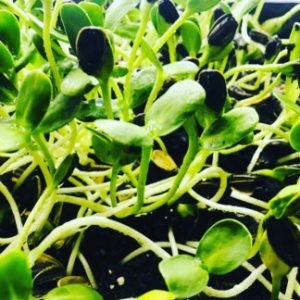Contents
The cotyledon is the first leaf to emerge from the soil medium when a crop seed undergoes a cultivation process. Since it’s part of the seed’s embryo, it becomes known as a seed leaf. It provides essential nutrients and vitamin to the baby greens until its true leaf forms after germination and begins photosynthesis. Many microgreen varieties have more than one cotyledon leaves, making them dicots. Those leaves are usually easy to identify, as they do not look like any mature plant leaves of mature vegetables.
Down and Dirty Cotyledons
 On dicots, seed leaves appear directly opposite one another on the central stem. They are typically smooth and plain looking with a square shape. Greens can have several leaves, but the ones that grow first are the smallest, so they will never look like the mature leaves of an adult plant. The sprouting process for some types of microgreens can start immediately, for others may take an extended period. When they sprout vertically, such as peas, the cotyledons will only be hidden below the ground during their growth cycle. During embryogenesis, both the cotyledon and primordial root develop and are carefully packaged into the package of seed by the momma plant.
On dicots, seed leaves appear directly opposite one another on the central stem. They are typically smooth and plain looking with a square shape. Greens can have several leaves, but the ones that grow first are the smallest, so they will never look like the mature leaves of an adult plant. The sprouting process for some types of microgreens can start immediately, for others may take an extended period. When they sprout vertically, such as peas, the cotyledons will only be hidden below the ground during their growth cycle. During embryogenesis, both the cotyledon and primordial root develop and are carefully packaged into the package of seed by the momma plant.
Many monocots, like grasses and lilies, have a single seed leaf that is also usually concealed.
High and Handsome True Leaves
The true leaves of a seedling unfurl above the cotyledons and look more attractive than seed leaves, and they are hairier. They have a wider range of colors and can be as long as the seedling’s true leaves. For flavorful microgreens to reach their true leaf stage just before harvest, lots of light is required. Energy is given to the plant by photosynthesis, and the first true leaves are no exception.
Telling the True From the Temporary
There are usually signs that the leaves of the fresh microgreens are cotyledons. Since these are the first ones the seedling produces on the stem, they are the ones holding onto an empty seed case. They also don’t look like the other leaves of their mature plant counterparts. For instance, cilantro cotyledons have oval shapes and the first true leaves are tri-lobed.
To Pinch or Not to Pinch
Unless the leaves that emerge are distasteful, others prefer to pinch off the cotyledons to avoid losing their flavorful stems. You may inadvertently break a seedling’s stem when you pinch off the microgreen leaves. Occasionally you will have to snip off the cotyledons of annual vegetable microgreens when dividing them. They prefer to be transplanted deeper than they grew here. Those varieties include tomato plants (Lycopersicon esculentum), and cabbage microgreens (Brassica spp. ), for which you need to remove the seed leaves and the infant plants so the first true leaves form just above the surface of soil.
Your trays of microgreens will begin to elongate quickly once taken out of their growing conditions. This could lead to the loss of concentrations of vitamins, minerals, and their intense flavor. Once you remove them from their growing environment, they must be eaten within 24 hours. Even though the flavors are more delicate than in the subsequent stage of growth, the microgreens are still of impact. Herb microgreens, like basil, cilantro, and parsley, are generally harvested after their first true leaves have begun to form.

